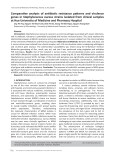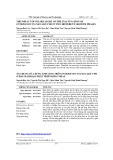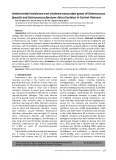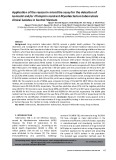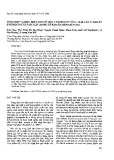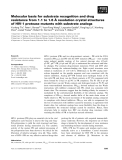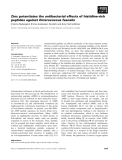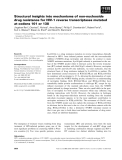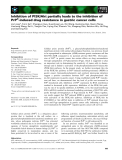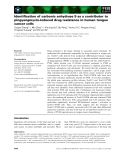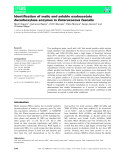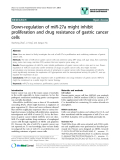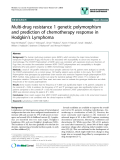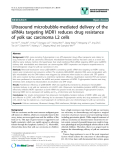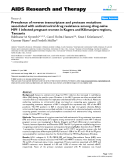
HUE JOURNAL OF MEDICINE AND PHARMACY ISSN 3030-4318; eISSN: 3030-4326 83
Hue Journal of Medicine and Pharmacy, Volume 14, No.6/2024
Antimicrobial resistance and virulence-associated genes of Enterococcus
faecalis and Enterococcus faecium clinical isolates in Central Vietnam
Tran Thi Bao Linh1, Ung Thi Thuy2, Le Van An2, Nguyen Hoang Bach2*
(1) Department of International Education, Hue University of Medicine and Pharmacy, Hue University
(2) Department of Microbiology, Hue University of Medicine and Pharmacy, Hue University
Abstract
Introduction: Enterococcus faecalis and E. faecium are prevalent pathogens in community and healthcare
settings, often resistant to multiple antibiotics. This study aimed to assess the prevalence of virulence factors,
drug resistance, and genetic determinants in clinical isolates in central Vietnam. Materials & Methods:
72 Enterococcus spp. isolates from patients at Hue Central Hospital and Hue University of Medicine and
Pharmacy Hospital were analyzed. Bacteria identification was implemented by biochemical tests and PCR
technique, and the antibiotic susceptibility testing was determined by using disk diffusion method. Results:
Antibiotic resistance rates were as follows: erythromycin (50.8%), ciprofloxacin (50%), penicillin (42%), high-
level gentamicin (34.7%), ampicillin (30.6%), tetracycline (28.5%), vancomycin (11.1%), and nitrofurantoin
(7.1%). Fosfomycin showed 100% sensitivity. Multi-drug resistance was observed in 27.8% of Enterococcus
faecalis/E. faecium isolates, with asa1 gene prevalence at 80.6% in E. faecalis and gelE at 74.2%, with hyl gene
at 6.4%. 64.3% of E. faecalis strains carried both asa1 and gelE genes, primarily in pus and urine samples,
notably high in MDR E. faecalis strains. Conclusion: This study highlights the prevalence of antibiotic resistance
and virulence genes in clinical Enterococcus spp. strains, emphasizing the need for infection control and
treatment strategies.
Keywords: Enterococcus faecalis, Enterococcus faecium, virulence genes, antibiotics resistance.
Corresponding Author: Nguyen Hoang Bach, Email: nhbach@huemed-univ.edu.vn.
Received: 3/5/2024; Accepted: 10/10/2024; Published: 25/12/2024
DOI: 10.34071/jmp.2024.6.12
1. INTRODUCTION
Enterococcus spp. are Gram-positive cocci
naturally occurring in the human and animal
gastrointestinal tract, as well as in feces, food, soil,
and wastewater [1], [2]. Previous studies suggested
that enterococci played a minor role in disease
causation. However, in recent years, Enterococcus
spp. has garnered significant attention as a notable
hospital-acquired pathogen. They have become
one of the leading causes of healthcare-associated
infections, with mortality rates in bloodstream
infections reaching up to 50%. Infections primarily
occur in hospitalized patients undergoing treatments
such as pelvic and abdominal infections, urinary
tract infections, wound infections, bloodstream
infections, endocarditis, and meningitis [1]. Among
these, Enterococcus faecalis and Enterococcus
faecium are the main pathogens, contributing to a
wide range of clinical [2]. Besides hospital-acquired
infections, Enterococcus spp. is also responsible
for 5-20% of cases of community-acquired
endocarditis [1].
The incidence of infections caused by Enterococcus
spp. is rapidly increasing due to their antibiotic
resistance and virulence traits [3], [4]. Natural and
acquired resistance characteristics associated with
this bacterial genus allow enterococci to resist
several antibiotic classes, including β-lactams,
aminoglycosides, and glycopeptides, making the
treatment of these infections challenging [1,2]. E.
faecium exhibiting vancomycin resistance is classified
by the World Health Organization (WHO) as a high-
priority pathogen, necessitating the development
of new antibacterial therapies. In Europe, the rate
of antibiotic resistance among Enterococcus spp.
ranks third after Escherichia coli and Staphylococcus
aureus [1]. The mortality and economic burden
posed by vancomycin-resistant enterococci (VRE) are
significant, with over 54,500 hospitalizations, 5,400
deaths, and $539 million in healthcare costs annually
in the United States alone [5]. In Vietnam, a study on
antibiotic resistance among gram-positive bacterial
pathogens causing urinary tract infections at the Huu
nghi General Hospital in Nghe An by Que Tram Anh
et al. 2022 found that E. faecium had the highest
resistance rate (40.7%), exhibiting 100% resistance
to several antibiotics including ampicillin, penicillin,
ciprofloxacin, and levofloxacin. E. faecalis ranked
second (33.0%), with a resistance rate of 63.3% to
quinolones [6]. Due to this resistance, clinicians face






